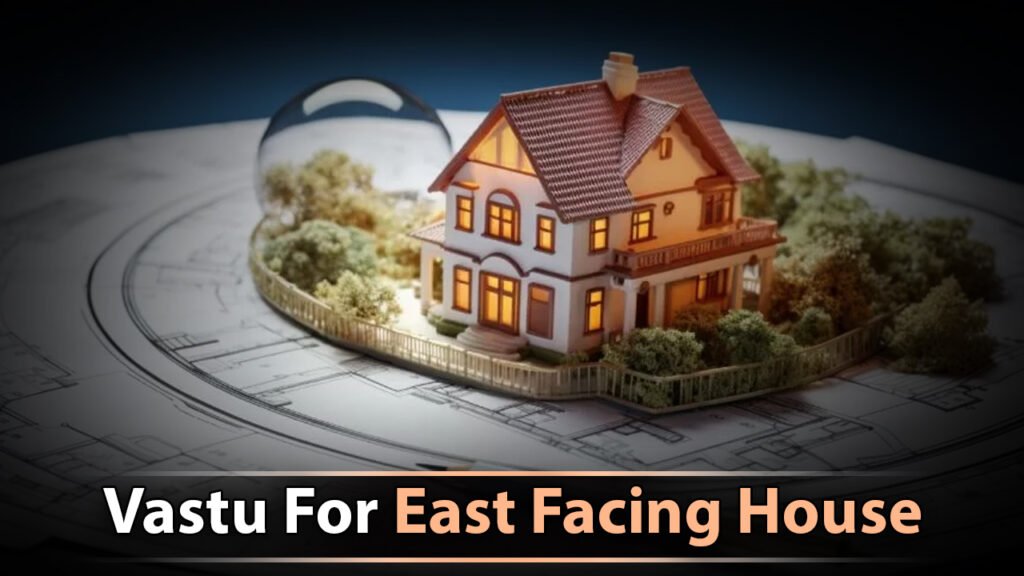Vastu For East Facing House
Vastu Shastra, the ancient Indian science of architecture, has been guiding people for centuries in creating homes that align with natural energies. Among the various house orientations, an east facing house is often considered highly auspicious due to its alignment with the rising sun. The east direction symbolizes new beginnings, growth, and vitality, making it a preferred choice for many homeowners. However, simply having an east facing house does not guarantee harmony and prosperity. Proper adherence to Vastu principles is essential to harness the positive energy of this orientation. In this blog, we will explore the key Vastu For East Facing House and address common concerns.
Read blog on: Vastu For West Facing House
Understanding East Facing Houses in Vastu
An east facing house is one where the main entrance faces the east direction. According to Vastu Shastra, the east is associated with the Sun, which represents light, knowledge, and life force. This direction is believed to bring positivity, health, and success into the home. However, neglecting Vastu guidelines can lead to imbalances, causing challenges such as financial instability, health issues, or strained relationships.
The key to maximizing the benefits of an east facing house lies in proper planning and design. By aligning your home’s layout with Vastu principles, you can create a space that fosters wellbeing, prosperity, and harmony.
Key Vastu Tips for East Facing Houses
1. Entrance and Main Door
The main door is the gateway for energy to enter your home. For an east facing house, the main door should ideally be located in the exact center of the eastern wall. Avoid placing the door too far to the north or south of the east wall, as this can disrupt energy flow.
Color: Use light colors like white, cream, or light green for the main door to invite positivity.
Decor: Add auspicious symbols like a Swastik or Om at the entrance to enhance positive vibrations.
Avoid Obstructions: Ensure there are no obstructions like trees, poles, or garbage bins directly in front of the main door.
2. Living Room Placement
The living room is a space for social interaction and relaxation. For an east facing house, the ideal location for the living room is the northeast (Ishan) or southeast (Agni) zones.
Furniture Arrangement: Place heavier furniture like sofas against the south or west walls. Leave the north and east walls relatively free to allow energy to circulate.
Colors: Opt for soothing colors like light blue, green, or white to create a calm and welcoming atmosphere.
Avoid Clutter: Keep the living room clean and clutter free to maintain positive energy flow.
3. Kitchen Placement
The kitchen represents the fire element and plays a crucial role in Vastu. For east facing houses, the ideal location for the kitchen is the southeast corner (Agni zone). This placement ensures that the fire element is balanced and supports the household’s health and prosperity.
Cooking Stove: The person cooking should face east while preparing food. This ensures positive energy flows toward the cook and the household.
Storage: Keep heavy utensils and appliances in the south or west part of the kitchen.
Avoid: Never place the kitchen in the northeast (Ishan) corner, as this can cause financial losses.
4. Bedroom Placement
The master bedroom should ideally be located in the southwest (Nairutya) zone of the house. This direction is associated with stability and strength, making it perfect for rest and relaxation.
Bed Placement: Position the bed so that your head points toward the south or west while sleeping. Avoid placing the bed directly under a beam or sloping ceiling.
Colors: Use calming colors like pastel shades, beige, or light brown to promote restful sleep.
Avoid Mirrors: Do not place mirrors opposite the bed, as they can disturb the energy flow and cause stress.
5. Puja Room Placement
The puja room or prayer area should be located in the northeast (Ishan) corner of the house. This direction is associated with spiritual growth and divine energy.
Orientation: Face east or north while praying to connect with positive vibrations.
Materials: Use natural materials like wood or stone for the altar. Avoid using leather or synthetic materials.
Avoid: Never place the puja room in the bedroom or near the bathroom, as these areas have conflicting energies.
6. Bathroom and Toilet Placement
Bathrooms and toilets should ideally be located in the northwest or southeast corners of the house. These areas are suitable for water and fire elements, respectively.
Placement: Avoid placing bathrooms in the northeast, as this can negatively impact health and finances.
Fixtures: Keep the toilet seat closed when not in use to prevent negative energy from escaping.
Ventilation: Ensure proper ventilation and lighting to maintain cleanliness and hygiene.
7. Balcony and Open Spaces
If your east facing house has a balcony or open space, utilize it wisely. Balconies in the north or east directions are ideal for plants and seating arrangements.
Plants: Grow small plants or herbs like basil (Tulsi) in the northeast corner to enhance positivity.
Avoid Clutter: Do not keep heavy objects or clutter on the balcony, as this can block energy flow.
8. Water Sources
Water sources like overhead tanks, borewells, or fountains should be placed in the northeast direction. This placement ensures the smooth flow of positive energy throughout the house.
Avoid: Never place water sources in the southwest, as this can lead to financial instability and health issues.
Common Concerns About East Facing Houses
Despite their reputation for being auspicious, some homeowners may still have concerns about east facing houses. Here are a few common queries and solutions:
1️⃣Morning Sunlight Glare: While morning sunlight is generally beneficial, excessive glare can be uncomfortable. Use blinds or curtains to moderate the light entering your home.
2️⃣Energy Flow: Ensure that all rooms are well ventilated and clutterfree to maintain a smooth flow of energy.
3️⃣Land Slope: Ideally, the land should slope downward toward the northeast to allow water and energy to flow smoothly.
Conclusion of Vastu For East Facing House
An east facing house, when designed according to Vastu principles, can be a haven of peace, prosperity, and happiness. By paying attention to the placement of key areas like the entrance, kitchen, bedroom, and puja room, you can create a harmonious living space that supports your wellbeing and success. Remember, Vastu is not about rigid rules but about aligning your home with natural energies to enhance your quality of life.
Whether you’re building a new home or renovating an existing one, incorporating these Vastu tips can make a significant difference. Embrace the wisdom of Vastu Shastra and transform your east facing house into a sanctuary of positivity and abundance.
If you want to watch Astrology Videos visit our YouTube channel: Acharya Ganesh
FAQs for Vastu For East Facing House
Q1. Why is an east facing house considered auspicious?
Ans- An east facing house is considered auspicious because it aligns with the rising sun, which symbolizes new beginnings, growth, and vitality. The morning sunlight also brings positive energy and improves health and wellbeing.
Q2. What are the benefits of an east facing house?
Ans- An east facing house offers several benefits, including:
Positive energy from the rising sun.
Improved health and vitality.
Enhanced opportunities for growth and success.
A sense of harmony and balance in the home.
Q3. Can I place the kitchen in the northwest direction in an east facing house?
Ans- While the ideal location for the kitchen is the southeast corner, the northwest direction can be used as an alternative if necessary. However, ensure that the cooking stove faces east and avoid placing heavy appliances in the northeast.
Q4. How can I reduce glare from the morning sun in an east facing house?
Ans- To reduce glare from the morning sun:
Use blinds, curtains, or frosted glass on windows.
Plant shrubs or install pergolas to provide shade.
Paint the exterior walls with light colored, heat resistant paint.
Q5. What should I avoid in an east facing house?
Ans- Avoid the following in an east facing house:
Placing the main door off center or obstructing it with poles or garbage bins.
Locating the puja room, kitchen, or master bedroom in the northeast corner.
Keeping the house cluttered or poorly ventilated.
Q6. Is it necessary to consult a Vastu expert for an east facing house?
Ans- While it’s not mandatory, consulting a Vastu expert can provide personalized guidance based on your specific house layout and needs. An expert can help identify and rectify any Vastu defects, ensuring optimal energy flow and harmony in your home.


